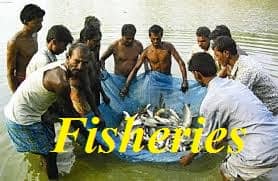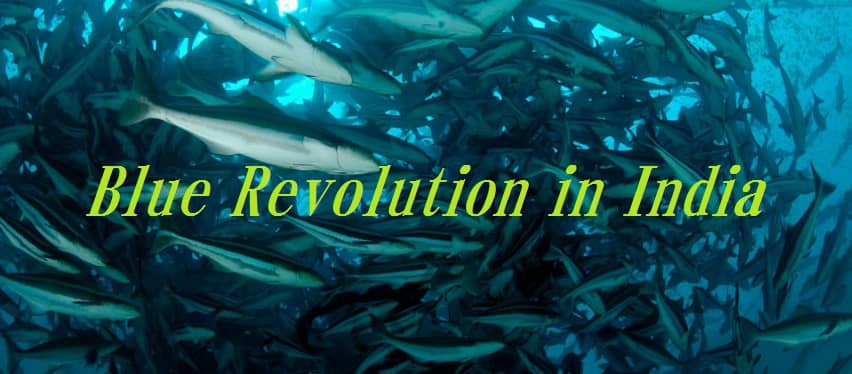Blue Revolution in India is described to be a package program of rapid growth in the production of fish and marine products. It refers to the time of automatic growth of the worldwide aquaculture industry from the mid-1960s to the present day growth of fisheries and aqua life.
Introduction to the Blue Revolution:
The Blue Revolution is an initiative taken by the Govt. of India for the growth of the Aquaculture Industry. This Revolution first began in China, where fishing was accounted for as an ancient activity. China accounts for around two-thirds of the total fisheries production worldwide by weight and half by market value.
Recently, the aquaculture industry has been seen growing at an average rate of 9% a year, and India is known to be one of the fastest growers in the aquaculture industry. The Department of Fisheries, Animal Husbandry & Dairy Farming (DFAHD) manages the Blue Revolution initiative under the banner of “Integrated Development & Management of Fisheries.”
Blue Revolution in India:
“Blue Revolution,” also called “Neel Kranti Mission in India,” was launched in the year 1985-1990 during the 7th Five-Year Plan (FYP). The main objective is to develop, manage & promote fisheries to double the farmer’s income and help them to sustain their livelihood. The Central Government of India during 1985-90 sponsored the Fish Farmer Development Agency (FFDA). During late 1992-97, the 8th FYP was launched, and eventually, the fishing harbors of Vishakhapatnam, Kochi, Tuticorin, Porbandar, and Port Blair were also established for regular workings and updates of aquaculture.
The Ministry of Agriculture & Farmers Welfare, along with FAD, decided to reconstruct the scheme with other aqua and agricultural schemes under the umbrella of “Blue Revolution” and restructure the scheme’s structural features. The scheme focused on the regular and development and management of fisheries under the hand of the National Fisheries Development Board (NFDB).
The components of the Blue Revolution are:
- NFDB & its activities
- Strengthening and Mobilizing the Geographical system of the Fisheries Sector
- Development of Fisheries and Aquaculture Land
- National Scheme for Welfare of Fishermen
- MCS & other interventions
- Institutional sectors and institutes for gaining Fisheries knowledge.
Also Read:
Importance of Blue Revolution:
The Neel Kranti Mission aimed to enhance India’s economic conditions through the enlargement of fisheries and food security in India. The proper and advanced utilization of water resources for aqua development was also done by the Blue Revolution in a sustainable manner.
The foremost importance of Blue Revolution are mentioned:
- Triple the production of the fish potential of India on both islands and the marine sector by 2020.
- Transform the Fish and Aqua Industry into the modern industry using technologies & processes.
- Double the income of fisheries through productivity increment and marketing infrastructure like E-Commerce, Global Investors, etc.
- Active participation of farmers in the growth and enhancement of income.
- Develop nutritional and food security in India.
- 20% of the world’s total intake of protein is from seafood, higher in coastal communities.
- Most pearls sold outcome from Pearl Aquaculture Farms.
- Potential Profits from fish is to be gained by cultivating in larger quantities.
The salient features of the Blue Revolution Scheme in India are stated below:
The various measures taken by the government to utilize the potential of aqua sectors under the Blue Revolution are:
- Fish Farmers Development Agency (FFDA):
- During the 7th Five-Year Plan, FFDA had improved the aquaculture by promoting new techniques for fish breeding, rearing, exports, etc.
- Intensive Marine Fisheries Programme:
- During the 8th FYP, the IMFP was launched.
- This was done with collaborations with many MNC’s.
- The State Government:
The state governments also have contributed to the growth of the fish and aqua sector:
- Gujarat had shifted from ponds to tanks and public auctions. It changed the tenure of contract from 1 yr to several yrs. They initiated huge investors and private entrepreneurs, increasing productivity.
- Jharkhand & Andhra Pradesh is also yielding very high returns from fishing and aquaculture in large reservoirs.
- Pradhan Mantri Matsya Sampada Yojana:
- Central Govt. Schemes seek to turn India into a hotspot for fish and aquatic market.
- This aims to bring all the fishermen under one scheme of farmer welfare.
- The govt. has allocated almost Rs.804.75 crore for the fisheries sector and targeted around 15 million tonnes of fish production by 2020-23.
- provides suitable linkage with “Sagarmala Project” of MGNAREGA, NRLM & RKVY, etc.
- Encouraging economically backward sections like SC’s, ST’s, Women & their co-operatives to take up fish and aquaculture.
- Showed 21st November as “World’s Fisheries Day” from 2016.

Impact of Blue Revolution in India:
- India is the world’s 2nd largest producer of fish, with exports worth more than Rs.50 000 crore.
- Asian countries contribute to 90% of aquaculture across the world.
- Fisheries in India’s single largest agriculture export in international markets with a growth rate of 6% – 10%.
- Indian Fisheries Sector reached a production of 4.7 million tonnes of fish, including 1.6 million of fish from freshwater aquaculture.
- The fisheries and aquaculture production gives a good contribution of almost 1% to India’s GDP and 5% to Agricultural GDP.
- India has an average annual growth of 14.8% in the production of fish and its products in the last decade.
- Various research centers were established in order to increase the production and improvise the species with particular tests.
- Several fishing harbors were established all across the nation.
- Assistance to Fisheries, almost 29,127.23 ha area of land were given under aquaculture.
Father of Blue Revolution:
Hiralal Chaudhari and Dr. Arun Krishnan are renowned as Father of Blue Revolution in India. The Blue Revolution in India was launched during the 7th Five Year Plan (1985-1990) during the sponsorship of the Fish Farmers Development Agency (FFDA) by the Central Government of India.
Scheme of Blue Revolution:

The Cabinet approved Rs 20,050-crore Pradhan Mantri Matsya Sampada Yojana (PMMSY) to bring about Blue Revolution in India through sustainable development of the fisheries sector over the next five years in March 2020. The government also works and aims to double the income of fish farmers and workers by 2024 through the scheme.
The PMMSY will address the critical gaps in the fisheries sector and its potential to develop fish production and increase its productivity at a sustained annual growth rate of about 10% to achieve a target of 22 million tons through sustainable and responsible fishing practices.
The total investment comprises of Centre’s share of Rs 9,500 crore, states’ share of Rs 5, 000 crores, and business’ share of Rs 6 000 crores.
- The PMMSY will be implemented with two separate components —
- Central Sector Scheme (100% grant by Centre) and Centrally Sponsored Scheme (60:40 between Centre and State).
- For any project approved under the Centrally Sponsored Scheme, the beneficiary will have to invest 60% while the Centre and the state together will contribute 40% remaining costs.
- In the SC/ST/woman beneficiary case, the government’s grant will be 60%.
The scheme is to be implemented between FY21 to FY25 targeting to create additional employment of 15 lakh fishers, fish farmers, workers, & vendors, and allied activities and 45 lakh indirect employment.
Frequently Asked Questions related to the Blue Revolution in India:
- What did the Blue Revolution aim to?
- Blue Revolution, popularly called the Neel Kranti Mission, has the vision to achieve economic growth of the country and the fishers and farmers as well as contribute towards the food and nutritional security of the nation.
- It will be done through the full potential utilization of water resources for fisheries development in a sustainable manner.
2. What are the impacts of the Blue Revolution in India?
- Perhaps the most pervasive effect of the Blue Revolution is that the rise in the production of carnivorous fish and shrimp has translated into a larger demand for fishmeal.
- Worldwide, a third of fish catches are devoted to fishmeal. The rise of a particular product has introduced new fisheries to tropical countries where they were virtually unknown previously.
- Who started the Blue Revolution in India?
- Hiralal Chaudhari and Dr. Arun Krishnan are known as Father of Blue Revolution.
- CCEA has provided the approval for which of the scheme towards realizing the Blue Revolution?
- CCEA has approved the implementation of an umbrella CSS scheme for integrated development and management of fisheries with an outlay of INR 3000 crore for 5 years.
- Blue Revolution is related to which field of the nation’s productivity?
- Fish Production & Nutritional Security.
- What is the main importance of the Blue Revolution?
- Fisheries hold an important position in the Indian economy. It provides income and employment to fishermen and farmers, particularly living in coastal areas.
- So, through the blue revolution, different techniques have been employed to increase production.
Conclusion:
Thus, the fishing sector must be endorsed through technological and infrastructural developments for it to become a major driver of the Indian economy and was boosted by the Blue Revolution in India.
